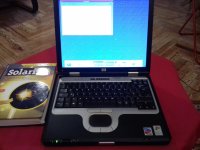I happened to have a HP Compaq nc6000 laptop in pristine condition lying around, which years ago I had stored away with the intention of running some old Linux on it, some day.
This is a top of the line, business oriented, premium quality laptop from the middle 2000's. It has rounded corners and, in my opinion, it's design is quite nice looking. It has the customary blue/pink "Intel Centrino" sticker, and also a "Designed for Windows XP" one - I find them both to be Oh so beautifully dated! The machine has 512 MB RAM and a 40 GB HDD - which is ultra massive capacity for "vintage" standards, but this is not really a vintage machine, just a very wonderfully obsolete one.
So some days ago, I was taking inventory of my CD-ROM collection, and I found the four CD distribution set of Solaris 9 x86, from year 2002. And I thought: I have to bring this thing back to life - I consider Solaris 9 to be the last classic Solaris, as Solaris 10 changed very much moving to the SMF service startup scheme (a kind of systemd precursor), Zones, ZFS, and assorted bells and whistles in which I have no interest at all (I appreciate UNIX minimalism). I value the historical pre-10 Solaris, as that was the golden standard Linux strove to follow when Linux was in its infancy through all of the 90's. Solaris 7 or 8 would have been equally fine, but I thought probably Solaris 9 would have better hardware support, therefore with Solaris 9 x86 I went for this project.
So now I have this new toy with Solaris 9 x86 on it. That was my first Solaris install (but I am a long time Linux user), and you can definitely smell old-school when going through its installation procedure. I managed to get X working (after several tries with the "kdmconfg" tool) with the --very dated-- CDE graphical environment, and I also got ethernet working with the built-in wired NIC (I haven't even tried to get the Intel Centrino wifi working, as I understand that is just not supported in Solaris 9).
Getting wired ethernet working was a real struggle, as Solaris 9 doesn't come with built-in drivers for this network card (Broadcom NetXtreme Gigabit Ethernet), but I got a working Solaris driver from here ( ftp://ftp.tyan.com/LAN/Broadcom/B57BCMCD826/Sol86/ ) and, also after several tries, I got it to "attach" which in Solaris parlance means getting the kernel driver module to see it's hardware. So I have Internet access from my new Solaris 9 toy!

This is a top of the line, business oriented, premium quality laptop from the middle 2000's. It has rounded corners and, in my opinion, it's design is quite nice looking. It has the customary blue/pink "Intel Centrino" sticker, and also a "Designed for Windows XP" one - I find them both to be Oh so beautifully dated! The machine has 512 MB RAM and a 40 GB HDD - which is ultra massive capacity for "vintage" standards, but this is not really a vintage machine, just a very wonderfully obsolete one.
So some days ago, I was taking inventory of my CD-ROM collection, and I found the four CD distribution set of Solaris 9 x86, from year 2002. And I thought: I have to bring this thing back to life - I consider Solaris 9 to be the last classic Solaris, as Solaris 10 changed very much moving to the SMF service startup scheme (a kind of systemd precursor), Zones, ZFS, and assorted bells and whistles in which I have no interest at all (I appreciate UNIX minimalism). I value the historical pre-10 Solaris, as that was the golden standard Linux strove to follow when Linux was in its infancy through all of the 90's. Solaris 7 or 8 would have been equally fine, but I thought probably Solaris 9 would have better hardware support, therefore with Solaris 9 x86 I went for this project.
So now I have this new toy with Solaris 9 x86 on it. That was my first Solaris install (but I am a long time Linux user), and you can definitely smell old-school when going through its installation procedure. I managed to get X working (after several tries with the "kdmconfg" tool) with the --very dated-- CDE graphical environment, and I also got ethernet working with the built-in wired NIC (I haven't even tried to get the Intel Centrino wifi working, as I understand that is just not supported in Solaris 9).
Getting wired ethernet working was a real struggle, as Solaris 9 doesn't come with built-in drivers for this network card (Broadcom NetXtreme Gigabit Ethernet), but I got a working Solaris driver from here ( ftp://ftp.tyan.com/LAN/Broadcom/B57BCMCD826/Sol86/ ) and, also after several tries, I got it to "attach" which in Solaris parlance means getting the kernel driver module to see it's hardware. So I have Internet access from my new Solaris 9 toy!

Last edited:


